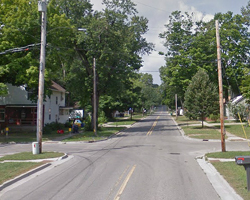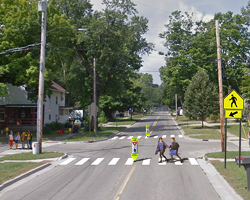It Takes More Than a Village to Create a Safe Route to School
- Timothy Gates, Ph.D.
- Associate Professor, Department of Civil and Environmental Engineering
- College of Engineering
- Wayne Beyea, J.D.
- Senior Specialist, School of Planning, Design, and Construction
- College of Agriculture and Natural Resources
Safe Routes to School (SRTS) is a program of the Federal Highway Administration that provides funding to states to help elementary and middle schools make improvements in infrastructure and programming to make it easier for children to walk, ride bikes, or use wheelchairs to get to school safely. While it used to be common for children to work and bike to school, today, many trips to school are made in private automobiles, contributing to a decline in physical activity, an increase in congested roadways around schools, and heightened concerns about the safety of children who do walk or bike to school.
In Michigan, the program is administered by the Michigan Department of Transportation (MDOT), who contracts with the Michigan Fitness Foundation (MFF) to oversee grant funding and coordination with schools. Katie Alexander is the Director of the Safe Routes to School program with the MFF. "Our main goal is to work with schools and communities to identify barriers to walking and biking to school, then help them identify solutions and to go through our technical process to apply for funding," said Alexander.
Municipalities in conjunction with schools and school districts may apply for one of two types of funding: infrastructure projects (engineering improvements) and non-infrastructure related activities (such as education, enforcement and encouragement programs). For some schools that determine the need for infrastructure improvements, the Michigan Fitness Foundation subcontracts to MSU's College of Engineering and School of Planning, Design and Construction (SPDC), who provide action planning, engineering and design recommendations, and data analysis assistance.
A Multidisciplinary Approach
Tim Gates heads up MSU's engineering related efforts on the Safe Routes to School project. He leads teams of engineering students in conducting traffic safety studies on primary routes to and from school, with the goal of reducing pedestrian crashes and injuries in the vicinity of schools. "We tend to focus on identifying issues related to infrastructure and traffic flow patterns, and proposing a series of proven countermeasures to help rectify these issues," said Gates. "These countermeasures are often included in funding proposals submitted by the local Safe Routes to School teams."

Before

After
Gates' colleague, Wayne Beyea (Urban and Regional Planning), who is the lead coordinator for MSU's overall efforts with the Michigan Safe Routes to School program, similarly works with teams of students and faculty on the planning components, while his colleagues, Karen Russcher and Warren Rauhe (Landscape Architecture) are instrumental in working with teams of design students.
"A unique aspect of this program has been our multidisciplinary approach, so that we not only have the engineering part of it, but we complement that with design and planning from our School of Planning, Design, and Construction," said Beyea. "Specifically, we recommend some best practices for walking and biking within the community, and then combine that with visualization tools so that they can actually see what improvements will look like."
Beyea also acknowledges the important role MSU Extension has in this partnership, both with funding and expertise. "The Safe Routes to School Program is also made possible by an important partnership with MSU Extension. Field educators in the MSUE Government and Public Policy team work closely with SPDC faculty to help identify and facilitate local SRTS projects," said Beyea.
Alexander agrees that there is value added in seeking MSU's expertise in the process. "It just takes it a step further for those communities going through the planning process before they apply for funding," said Alexander. "A lot of communities wanted to visualize what it was that they would be applying for, but they couldn't quite conceptualize what that could look like. The teams at MSU have a really great framework to provide that for communities."
The Six E's of Safe Routes to School
Each of these elements is integral to the long-term success of a Safe Routes to School action plan.
EVALUATION
Create a snapshot of the current situation at the school or district, incorporating an assessment of the physical and social environment, as well as concerns of parents and students.
ENGINEERING
Implement improvements to the built environment, in the design of streets, sidewalks, signage, traffic lights, and intersections, based on survey data.
EDUCATION
Provide educational opportunities to students, parents, school staff, and the community, with the goal of altering cultural norms around safety.
ENCOURAGEMENT
Offer events that inspire students, parents, elected officials, and school leaders to try new ideas for developing programs that encourage walking and bicycling.
ENFORCEMENT
Partner with law enforcement to ensure that traffic laws are obeyed in the vicinity of schools, and initiate community enforcement, such as crossing guard programs.
EQUITY
Work to support safe, active, and healthy opportunities for children and adults in low-income communities, communities of color, and beyond.
*Information taken from the Safe Routes to School National Partnership Website
A Collaborative Effort
The teams of students, faculty, and Extension educators from MSU join many other state and local stakeholders— principals, teachers, parents, public safety personnel, bus drivers, advocacy groups, health organizations, and representatives from the MFF—in an intensely collaborative technical process designed to prepare the schools to apply for funding.
This steering committee begins the process with a visioning meeting, in which they evaluate the current walking/biking situation—what's working or not working so well and what their future vision is for the area. They also gather information by distributing surveys to students and parents, and by conducting a walking/biking audit, where the stakeholders actually walk the various school routes to determine the physical barriers—as well as social barriers—that hinder children from walking or biking to school safely. These barriers can include anything from dangerous intersections to aggressive dogs to overgrown brush.
Armed with this information, the MSU engineering and planning and design teams get to work on developing solutions and recommendations in the form of an action plan, which they present to the steering committee in a second meeting. After gathering more feedback, the teams again work to refine the action plan.
This student involvement is important, both to the planning process and to the students. "It's been a wonderful opportunity to have engineering graduate students and planning and design students working together in a collaborative community-based project—that we're able to do some applied research with this outreach component," said Beyea. "It's real world stuff. We're a practice oriented profession, so it's very important to get students engaged in these communities with these types of projects and then be able to have our researchers help us identify some of the best practices that we can implement at the local level."
After presenting their final recommendations at a third meeting, the school is positioned to apply for funding. "That's one of the key aspects that makes this not just a pipe dream," said Beyea. "We've had a very good track record of working with schools that have gone through the process, that then are successful in going forward with actual built projects." He is thrilled with the proactive role MDOT and the Fitness Foundation play in developing the local action plans. "They provide assistance to guide communities in getting the funding and support they need to actually develop a culture of walking and biking, so that after the grant is sought, they're in a position to keep the momentum going."
A Growing Success Story
Alexander is excited by how much the interest in SRTS has grown over the last four years. "We're busier than ever, and I can say the same thing for MSU," she said. "It seems that the requests for their work have done nothing but gone up over the last four years. It's really exciting, because we feel that it's building momentum here in the state, and a lot of communities are looking to go through that Safe Routes to School planning process and complete the application to get funding to help make it safe for their students to walk and bike to school."
She recalls feedback she received from the Harrison School District. "We had a community that just built their project last summer, and they came out and did a presentation [at the Michigan Association of Planning Conference] on the program, and to hear the feedback on it was remarkable. They applied for three schools worth of funding, and the amount of work they did for the amount of funding that they got was pretty substantial. They were able to leverage a lot of partnerships to make that happen, and they were really encouraging the community to go through that planning process. When the workers were out doing construction, the kids were walking by the areas where that work was happening, and the construction workers were telling them that this was a project that was going to benefit them. The kids were so excited to see that happen."
This is the kind of feedback Gates likes to hear. "It is always nice to receive feedback later on from schools that successfully implemented some or all of the recommendations, especially when it improves walking and biking activity throughout the community," said Gates. "These communities often experience a much broader awareness of the benefits of walking and bicycling and work to improve and promote safe walking and bicycling throughout the community."
Sources
- SRTS Guide. 2011. Retrieved from: http://guide.saferoutesinfo.org/introduction/the_decline_of_walking_and_bicycling.cfm
- Written by Amy Byle, University Outreach and Engagement
- Photographs courtesy of MSU School of Planning, Design, and Construction
- Image courtesy of Michigan Department of Transportation